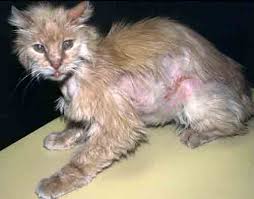Archive for December 19th, 2015
Hyperthyroidism in Cats
Saturday, December 19, 2015
 My cat Molly’s Thyroid is slightly overactive. Cats that have hyperthyroidism display specific symptoms. Although Molly displays some of these symptoms, her condition is not advanced and will be analyzed by her vet. Symptoms to look for are:
My cat Molly’s Thyroid is slightly overactive. Cats that have hyperthyroidism display specific symptoms. Although Molly displays some of these symptoms, her condition is not advanced and will be analyzed by her vet. Symptoms to look for are:
- Weight Loss – this is a typical sign in Hyperthyroidism.
- Increases appetite – Molly has this one. She constantly wants to eat This increase in appetite can be dramatic, with some cats doubling the amount of food eaten and frequently begging for food. Hyperthyroid cats eat more in an attempt to compensate for their higher-than-normal metabolic rate by increasing the number of calories ingested.
- Increased energy or nervous behavior. So far, Molly is not displaying this symptom.
- Increased thirst and urination. Yes Molly has this one. Always drinking. I bought her an automatic water fountain.
- Vomiting or regurgitation. Vomiting may result from a direct action of thyroid hormones on an area of the brain called the chemoreceptor trigger zone.
- Anxiety and night yowling. Nope Molly is not displaying this at all.
- Diarrhea and soft stools.
- Fast respiratory rate, panting and difficulty breathing.
- Skin, hair and coat changes.Skin and hair coat changes often develop in hyperthyroid cats. The hair coat, especially in long-haired breeds, is often unkempt, dull, and may even be matted.
Take your cat to the vet if you notice these symptoms. Fortunately, hyperthyroidism is very treatable with medication. After all, I have it myself.
add comment
Comments Off on Hyperthyroidism in Cats